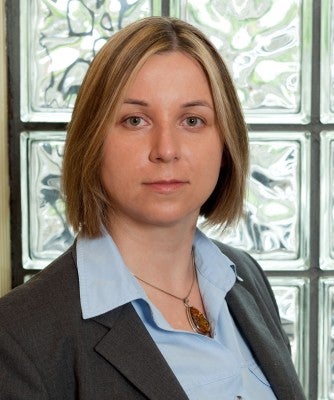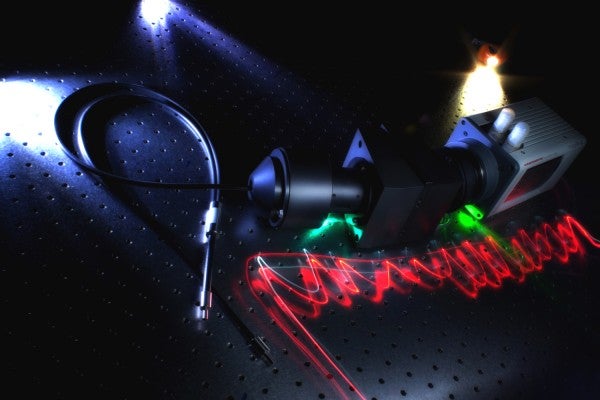
Great optics for endless possibilities
Spectrometers that can determine an over-the-counter or prescription pill’s composition without making a single cut

Spectrometers that can determine an over-the-counter or prescription pill’s composition without making a single cut
By Kira Vermond Faculty of EngineeringSplitting a pill in two usually means cutting its strength in half as well. But what if the active ingredient was dispersed improperly and concentrated on only one side? That half pill could either be rendered inert or worse, poisonous.

Systems design engineering graduate Olga Pawluczyk is the president and CEO of P&P Optica Inc., a company that develops advanced spectrometers for biomedical and other purposes.
Fortunately, those in the pharmaceutical industry with access to one of Olga Pawluczyk’s spectrometers can determine an over-the-counter or prescription pill’s composition without making a single cut.
Pawluczyk is the president and CEO of P&P Optica Inc., a Waterloo-based technology company that develops advanced spectrometers. The machines use light to establish chemical compositions of different substances and are widely considered one of the most sensitive, efficient and accurate on the market. The Waterloo systems design engineering alumna calls the technology the “next logical step after the camera,” particularly for industrial usage, as well as for mining, oil and gas, defense, and healthcare.
“Imagine you now have a better camera—a spectroscopic camera—that can tell you something is not only the right shape and colour, it’s the right chemistry,” she says.
The company was started by Pawluczyk’s father and brother in 1995. Six years later Pawluczyk joined and became CEO in 2004. Since then, the company has doubled the number of employees and expanded its reach beyond research labs to include industrial applications.
Nearly three years ago, P&P Optica moved to Waterloo to open a facility that builds the heart of a spectrometer, the defraction grating, which behaves like a prism, splitting light into multiple colours. “They make rainbows,” Pawluczyk explains. Those colours indicate chemical structures within an item.
The technology has also been used to analyze multiple components of blood at the same time so doctors can quickly conduct several tests using only one vial of blood. It  can also determine the chemical differences between transparent plastics, what Pawluczyk considers one of its biggest successes to date.
can also determine the chemical differences between transparent plastics, what Pawluczyk considers one of its biggest successes to date.
To a human eye, five bottles may look identical although they’re crafted from different materials. The company’s spectrometer system makes it easier for recycling companies to sort them.
Pawluczyk says her Waterloo Engineering undergraduate education set her on the path to where she is professionally today. In particular, it was the school’s dedication to solving real world problems, even in the classroom.
“That’s what makes you excited, right? It’s not solving a differential equation from a textbook. It’s solving the differential equation to predict flow of blood in arteries,” she says.
Pawluczyk is inspired by how Waterloo has embraced the entrepreneurial spirit in recent years. Although the University has always been at the forefront of entrepreneurism and encouraging students to think beyond the theoretical, support for business startups and real world applications is giving graduates the skills they need to thrive in today’s markets. In fact, P&P Optica is known for hiring Waterloo grads and co-op students, working with four over the past few years.
Pawluczyk says having a good, solid education in engineering from Waterloo has made the difference to her career and provided her with the ability to envision multiple uses for P&P Optica’s spectrometers from military surveillance to biomedical purposes, including cancer detection.
“Engineering at Waterloo allows you to look at what, on the surface, seems like very separate problems, and distill them down to their basic components,” she says. “When you apply logical principles, eventually you don’t see problems, you just see solutions.”

Waterloo researcher Dr. Tizazu Mekonnen stands next to a rheometer, which is used to test the flow properties of hydrogels. (University of Waterloo)
Read more
Plant-based material developed by Waterloo researchers absorbs like commercial plastics used in products like disposable diapers - but breaks down in months, not centuries

Read more
Here are the people and events behind some of this year’s most compelling Waterloo stories

Engineering master's student Nayeema Nonta (left), one of the three paper authors, and her supervisor, Dr. Sirisha Rambhatla, in a large server room with the computer power needed to develop their new LLM training technique. (University of Waterloo)
Read more
Waterloo researchers develop highly efficient AI training system that paves the way for cheaper, greener “intelligent partners”
Read
Engineering stories
Visit
Waterloo Engineering home
Contact
Waterloo Engineering
The University of Waterloo acknowledges that much of our work takes place on the traditional territory of the Neutral, Anishinaabeg, and Haudenosaunee peoples. Our main campus is situated on the Haldimand Tract, the land granted to the Six Nations that includes six miles on each side of the Grand River. Our active work toward reconciliation takes place across our campuses through research, learning, teaching, and community building, and is co-ordinated within the Office of Indigenous Relations.